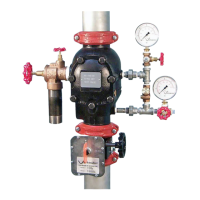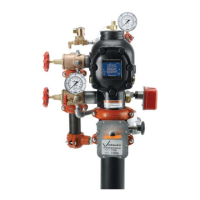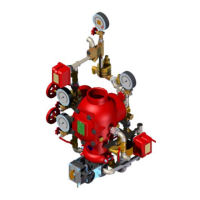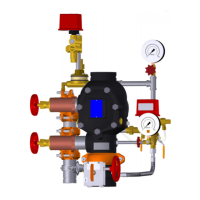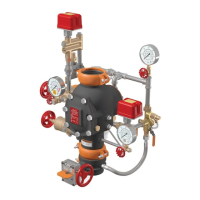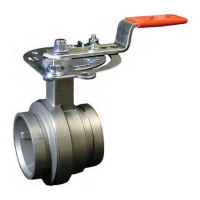12
Water Flow Alarm Test
Perform the water flow alarm test on a frequency required
by the current NFPA-25 code. The authority having juris-
diction in your area may require that you perform these
tests on a more frequent basis. Verify these requirements
by contacting the authority having jurisdiction in your
affected area.
1. Notify the authority having jurisdiction and those in the
affected test area that a test is in progress.
2. Open the water supply main drain fully and flush the
water supply of any contaminants.
3. Close the water supply main drain valve.
Note: Photo taken of alarm valve for clarity of ball valve’s location.
4. Close the alarm line ball valve.
Note: Photo taken of alarm valve for clarity of ball valve’s location.
4a. Open the alarm test ball valve in the preaction sys-
tem’s trim. Confirm that mechanical and electric alarms
provided are activated and that remote monitoring sta-
tions, if provided, receive an alarm signal.
5. After ensuring proper operation of all alarms, close the
alarm test ball valve and open the alarm drain ball valve,
located in the trim below the alarm test ball valve. Verify
that all alarms stop sounding, that the water motor alarm
has drained properly, and that remote station alarms reset
properly.
6. Confirm that the alarm test ball valve is closed. Close the
alarm drain ball valve. Open the alarm line ball valve.
7. Verify that the intermediate chamber of the preaction
system is dry. No water should flow from the ball drip.
8. Notify the authority having jurisdiction, remote station
alarm monitors, and those in the affected area that the
valve has been placed back in service.
Water Level and Low Air Alarm Test
Perform the water level and low air alarm tests on a fre-
quency required by the current NFPA-25 code. The author-
ity having jurisdiction in your area may require that you
perform these tests on a more frequent basis. Verify these
requirements by contacting the authority having jurisdic-
tion in your affected area.
1. Notify the authority having jurisdiction and those in the
affected area that the test will be in progress.
2. If the valve is equipped with a Series 746 Dry Accelera-
tor, close the ¹⁄₂-inch isolation ball valve.
3. Open the water supply main drain valve to flush any
contaminants that may have collected.
ALARM LINE
BALL VALVE
ALARM TEST
BALL VALVE
NOTICE
• Be sure to notify the authority having jurisdiction that a test is in progress. Closing
the isolation ball valve of the Series 746 Accelerator may cause the valve to trip, re-
sulting in a false alarm.
